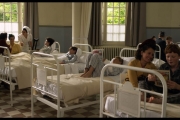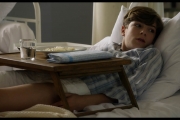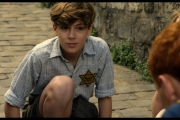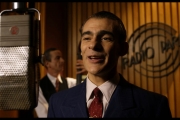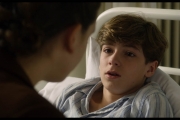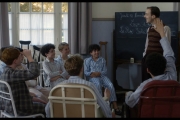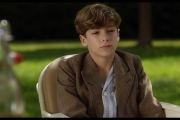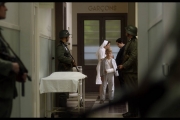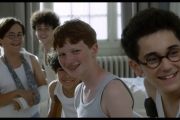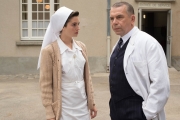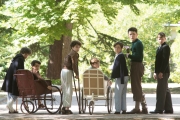![]() Presentation by and discussion with actor Philippe Torreton
Presentation by and discussion with actor Philippe Torreton
July 1942. Taken to Garches Hospital to treat a broken leg, twelve-year-old Maurice Gutman barely escapes the rounding up of Jews which takes his family away. At the hospital, Doctor Daviel diagnoses Maurice with tuberculosis, which will require a lengthy treatment. Maurice and eight other young patients will live through, along with the hospital staff, an unforgettable experience, full of friendship, solidarity, and extraordinary courage. These children are the lucky-ones. Their story is true.
Cast & Crew
Director / Screenwriter • Malik Chibane, based on a true story
Director of Photography • Lubomir Bakchev
Music composer • Adrien Bekerman
Producer • Manuel Munz
Starring :
Philippe Torreton, Mattéo Perez, Mathias Mlekuz, Pauline Chevillier…
Choose a picture to see the filmography (source : IMDB)
![]()
Director Malik Chibane’s statement
The director Malik Chibane brings the story of Maurice Grosman, a Polish Jewish child, to the screen. It is set during the anti-semitic repression of the Second World War. In this film, he lends the fictitious name of Maurice Gutman to the real character.
Films that alternate between major and minor stories form a separate, fully fledged cinematographic genre that I particularly enjoy, both as a spectator and as a director.
We will never stop trying to understand the period of the Occupation in spite of the numerous accounts, works and major documents that we already know and I remain convinced that we can still revisit this part of our history by exploring another viewpoint. Future generations will never meet miracle survivors like Maurice Grosman, so cinema can bring these heroes to us with the appropriate narration and the vast power of identification that is characteristic of this art.
I am extremely sensitive to historical events that sweep away – or indelibly influence – the existence of a family. My parents often told me about their three wars: the Second World War with the American convoy driving through their Kabyle village, when my uncle, who was an officer, left Tunis to travel to Berlin with thirty armoured cars. The other two wars are connected with the decolonisation of Indochina and Algeria. The implausible and the improbable always crop up in real life and my family’s photo album bears witness to this, as does that of Maurice Grosman.
In Maurice Grosman’s real life, I was surprised by the series of lucky breaks that allowed him to escape a tragic fate. A fracture avoided him being rounded up, another fracture revealed he was suffering from tuberculosis of the bones, a fake plaster protected him from another round-up, adulterated penicillin treated his tuberculosis. People call it chance, a lucky star, a guardian angel . . . these words are used because we are sometimes struck dumb by these happy coincidences due to a twist of fate or unexpected luck. These events form the great story of little Maurice’s life.
Truth is often stranger than fiction and in my capacity as storyteller, I am pleased that the knowledge of this true fact, which inspired a film, is the fruit of an encounter. Les Enfants de la Chance is the outcome of several meetings with Maurice Grosman.
I was disturbed by the geographical proximity of the places where the action in my film takes place, between the 18th district in Paris and Garches Hospital – I know the area well. Madame Grosman was a Polish-Jew-Parisian at the time. She was born in the Rue de l’Atlas in Belleville. The maternity ward where she gave birth has become a clinic where I take my children.
Madame Grosman went to the local school, where my daughter voted for the first time in May 2012. Maurice’s aunt lived in the 10th district, where I now live.
Every day, I go down the streets and avenues that little Maurice walked to go back to the woman who replaced his mother. Another element that fascinates me is the difference between the image that the Grosman boys had of that period in their father’s life – obviously sad, dark and depressing – and the story Maurice Grosman told me: a sad time, obviously, due mainly to the absence of his family but interspersed with bright and happy times.
How can children cope in such situations?
It must be by escaping from the routine and sometimes oppressive reality in which the enemy is neither the 3rd Reich Army, nor disease, but boredom. To resist this boredom, playing games and a fantasy world are essential if one is to remain able to be filled with wonder at being alive and to lend the most humdrum events a rare intensity. Highlighting this side of Maurice Grosman’s story appealed to me: it showed me the universal side of these children’s story: in the children’s hospital for two years during the war, they resisted in their own way by drawing energy from their imagination. They composed another reality for themselves; they dreamed of their favourite cakes while they eat carrots fantasizing about their favorite pastries, they disrupted a grammar lesson by imitating a horse, they instilled a burlesque spirit à la Charlie Chaplin into the caretaker . . . They display resilience without knowing it.
Like all adults of my generation, I still have the mark of the BCG on my left shoulder. This vaccine eradicated tuberculosis, the same disease suffered by Maurice Grosman and other children in the long-term ward at the hospital. I wanted to tell you about this disease as if it was a story for which very often, the only remedy was amputation. Several scenes deal closely with the disease: the scene in which Doctor Daviel explains his illness to Maurice, the scene in which the German medicine – Prontosil – is delivered or the one in which the Doctor announces to certain children that they are cured when he examines their X-rays . . .
This dramatization allows us to better apprehend the Doctor’s expectations for American penicillin. Finally, the last facet of Maurice Grosman’s testimony that particularly resonates with me: he is the son of immigrants: he speaks two languages, one at home and the other outside, his mother tongue is not French but Yiddish, he switched between the two languages that convey two ways of thinking, two worlds in which he is a natural intermediary. I have experienced this type of situation.
Maurice was constantly using trickery. He interpreted, showing great understanding and finally had to adapt so that the Authorities and the school would understand his parents and that he, himself could be understood by his own parents. The little boy from the 18th district was not a Pole like them but a young French lad, who went to school every day. Maurice’s resilience is perhaps rooted in his ability to adapt to a variety of – sometimes dangerous – situations.
Maurice Grosman told me that his mother tongue gradually lost ground whereas his French improved considerably. And then one day he forgot it altogether and his mother was no longer there to drag out the words and expressions that were buried deep in his memory. Without his aunt, the only survivor in the family, Maurice would not still be a custodian of this ancient language from Central Europe. Today, Maurice, an old man, dreams in French but thinks of his parents in Yiddish and his thoughts are precious.
Identity and integration are stil part of our current political context since the French Revolution and the establishment of the jus soli principle. As a citizen, I remain convinced that the commemoration of the Shoah represents a shield that protects the children, grandchildren and great-grandchildren born of immigration.
Press Kit “Les enfants de la chance”
French ~ 16 pages ~ 5,8 Mo ~ pdf



